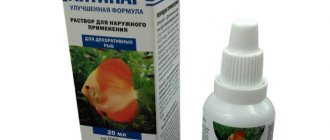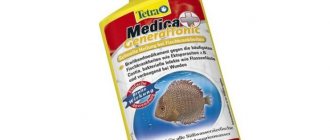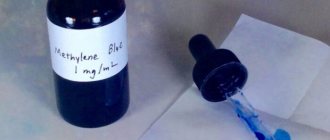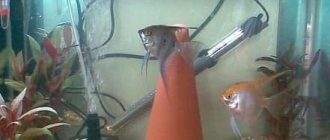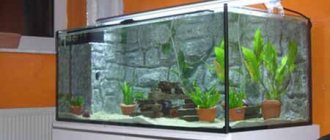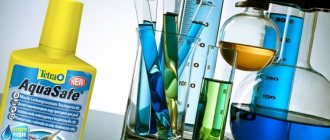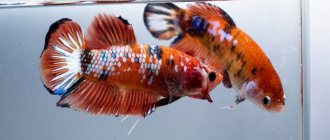Symptoms
Infected fish rub against rocks and plants and press their fins. Sometimes I lose my appetite. When viewed with the fish's head facing the observer, a bluish-matte coating is visible along the lateral line and slightly above it. In the worst case, the skin comes off in patches. When the gills are destroyed or damaged, there is no plaque, the fish is restless, often swims to the surface of the water, sometimes tries to jump out, then becomes lethargic. When gills become infected, massive fish deaths often occur.
Photo: Chilodonella
Causes
Invasive disease. The causative agent is the ciliate Chilodonella cyprini, with a heart-shaped, elongated, flattened, transparent body covered with cilia. Reproduces by dividing in two. Chilodonella cyprini lives on cold-water fish and prefers temperatures between 5-10 degrees, and for warm-water fish at temperatures above 20 degrees the disease is not dangerous. Under poor conditions, including elevated temperatures (from 25 degrees), the pathogen forms a cyst that can survive this period and remain viable for a long time without fish. It enters the aquarium from a reservoir where fish are found, along with food, plants and soil, if it has not been boiled or calcined, as well as with fish, plants, water and equipment from an infected aquarium. The pathogen affects the skin and gill apparatus. Healthy, strong fish do not die from Chilodonella. In such fish, only mild infestation by individual parasites occurs, which do not particularly harm the fish. If the fish are previously injured, this results in massive lesions on the skin and gills. This means certain death of infected fish if treatment is not carried out immediately.
Aquarist's Guide
DISEASES CAUSED BY CILATES
Chilodonellosis
is an invasive disease of freshwater fish.
Many aquarium, pond and commercial fish get sick. The causative agent is the ciliate Chilodonella cyprini
of the Clamidodontidae family, order Holotricha. The length of the parasite is 45–70 µm, width 38–57 µm. The body is flattened in the dorso-ventral position, covered with cilia,
which serve as a means of transportation for ciliates. On the ventral side, closer to the anterior end, there is an oral opening, from which extends a short pharynx, equipped with a rod-like chitinoid apparatus consisting of 18 rods. In the middle of the body there is a nucleus, and closer to the edges there are two contractile vacuoles.
Once on the fish, Chilodonella is localized on the surface of the skin, feeding on mucus and exfoliated epithelial cells. With the help of cilia, the parasite moves freely along the skin of the fish. Ciliate reproduction also occurs there by dividing in two in the transverse direction.
Chilodonella mainly parasitize on the surface of the skin of fish. A mixed form of chylodonellosis often occurs, when the parasites are localized on the skin and gills. Under unfavorable environmental conditions (changes in the hydrochemical regime, a sharp increase or decrease in water temperature, etc.), the ciliate forms a cyst. Cyst formation is accompanied by increasing rotation of the parasite in one place, the speed of which reaches 30 revolutions per minute. After 1.5-2 hours from the beginning of cyst formation, contractile vacuoles increase, and the rate of their pulsation slows down. The cilia and rod apparatus of the pharynx disappear, the nucleus becomes rounded, and the protoplasm acquires a pronounced granularity. By the end of the cyst formation process, the contractile vacuoles disappear, the rotational movements of the ciliate stop, and a double shell with a denser outer layer forms around it. The entire process of cyst formation lasts 3.5-4 hours.
Cysts can survive for a long time in the soil and water column. When the cyst gets into conditions favorable for development, the cyst shell dissolves and an infusoria emerges from it, which attacks the fish and parasitizes it. Bright, especially sunny, light prevents the proliferation of parasites, and the defect kills them.
In most literary sources Ch. cyprini is described as a cold-loving ciliate that reproduces at water temperatures of 8-10° and dies at temperatures above 20°. This is confirmed by numerous cases of outbreaks of fish chylodrnellosis in pond farms precisely at the end of winter .
early spring, when the water temperature in the ponds warms up to 8-10°. Despite this, we cannot attribute Gh. cyprini is one of the cold-loving ciliates, since they parasitize exotic fish, and the water temperature in aquariums is above 20° all year round. At the same time, one of the sources of the spread of chylodonellosis in aquarium fish farming is ciliates brought into indoor reservoirs from natural ones with live food, water, vegetation and soil. We have established that Ch. cyprini taken from natural reservoirs, where the water temperature is 5-10°, and placed in aquarium water (23-25°) are not capable of causing disease in exotic fish in the first 2-3 days, since they themselves “get sick”, adapting to new conditions. them to environmental conditions. At the same time, we should not forget about the sharp change not only in temperature, but also in pH, hardness, oxidability of water and a number of other hydrochemical indicators, as well as a change in the hosts themselves (fish). Having found themselves in new environmental conditions, one part of the ciliates dies, the second forms cysts (encysts), and the third, by the end of the third or fourth day, adapts not only to the high water temperature and hydrochemical regime, but also proceeds to parasitism, settling on new ones. types of fish. Unfortunately, the fate of encysted ciliates has not been studied.
The accuracy of our research results is confirmed by the year-round parasitism of Ch. cyprini on aquarium fish at water temperatures of 22-27° and cases of mass death of fish from chylodonellosis at these temperatures at different times of the year. Temperature optimums for the growth and reproduction of Chilodonella, which have adapted to aquarium fish, currently remain unstudied.
Epizootology
. Chylodonellosis affects most aquarium fish of all age groups, but fry and juveniles that have not reached sexual maturity are more susceptible to the disease.
Chilodonellosis can be characterized as a disease associated with dystrophy. As a rule, not only weakened, poorly nourished fry and juvenile fish get sick, but also adults. Chilodonellosis is especially common in fish kept in poor conditions (low water temperature, improper hydrochemical regime, unsanitary condition of the aquarium, etc.), with inadequate, monotonous feeding. As a result of poor housing and nutritional conditions, epithelial cells of the skin die and are the best substrate for the life and reproduction of ciliates.
The causative agent of the disease spreads with live food, water, soil and aquatic vegetation from reservoirs where wild fish live (especially in late winter and early spring); with purchased fish that have not undergone quarantine and have not been treated in therapeutic and prophylactic baths; with aquatic vegetation, soil and water taken from an aquarium that is unaffected by chilodonellosis; with nets, scrapers, feeders and other fish farming equipment common to all aquariums.
Symptoms and pathogenesis.
The parasite, moving along the surface of the skin, irritates the nerve endings, causing anxiety in the fish. At first, the fish makes oscillatory movements with its whole body, remaining in one place or slowly moving forward. Upon careful examination of the surface of the skin, when the fish is positioned with its head towards the observer, one can see a dull white tint covering the body of the fish along the lateral line and above it.
With more severe parasite damage, the fish rubs against plants and various objects located at the bottom of the aquarium (stones, shells, decorative roots, etc.). By this period, almost the entire body of the fish is covered with a bluish-gray coating, which is formed as a result of the body’s protective reaction and is caused by intense mucus secretion. Due to abundant mucus secretion, skin respiration is disrupted, which in juvenile fish plays a significant role in the general respiratory process. The fish behaves restlessly and often jumps out of the water. Some individuals that willingly accepted food before this period stop feeding.
The course of the disease is complicated by other ectoparasites (Trichodines, Gyrodactylus, etc.).
Often an outbreak of chilodonellosis ends in the mass death of fish.
Diagnosis
diagnosed on the basis of a microscopic examination of scrapings of mucus from the skin of the fish and the detection of the pathogen in them. According to clinical signs and course, chylodonellosis is very similar to costiosis, trichodinosis and gyrodactylosis.
Treatment
. If the extent of invasion in the aquarium is quite large (almost all fish have a pronounced disease) and the death of the fish is observed, treatment in short-term baths is contraindicated, since the fish’s body is significantly weakened. In this case, the treatment takes into account the biological characteristics of the parasite. In the aquarium, the water temperature is increased to 30-32°, and at the same time it is aerated. The set temperature regime is maintained until the fish begin to actively feed and become stronger. High temperature kills some of the parasites, but a certain number of them become encysted. After the water temperature drops to normal, the cyst dissolves and the parasite attacks the fish again. That is why treatment by increasing the water temperature does not completely free the population, soil and vegetation of the aquarium from infectious elements, but only temporarily frees the fish from parasites. Only after the fish are sufficiently strong (during this period they are intensively fed with live food) can treatment begin in a separate vessel by treating the fish in short-term medicinal baths.
If chilodonellosis was diagnosed at the very beginning of the disease, and the fish are sufficiently well-fed, treatment can be carried out in short-term baths without prior exposure to high temperature.
When treating fish, medicinal solutions are used in a separate vessel: potassium permanganate (KMnO4), the course of treatment lasts 7 days; copper sulfate (CuSO4•5H2O), treatment is carried out for four days; malachite green (strictly according to the method described in the book); basic violet K; bicillin-5.
For any of these methods of treating fish, fresh solutions of medicinal drugs are prepared daily.
When treating fish in a general aquarium, bicillin-5, methylene blue, malachite green with copper sulfate are used. Methods for using the listed drugs are described in the section “Treatment of fish in a general aquarium”.
Prevention comes down to creating optimal housing conditions, proper feeding of fish and avoidance of dense plantings, especially in nursery aquariums. Newly acquired fish should be kept in quarantine and put through anti-parasitic baths.
The introduction of the pathogen from water bodies where wild fish live, as well as from aquariums that are unfavorable for this invasion, should not be allowed.
To previous page
(Visited 812 times, 1 visits today)
Treatment
The fish are transplanted into a quarantine aquarium, to which 0.04 mg/l of malachite green is added. After two days, the fish are free of parasites. If fish death is observed in the general aquarium, then drug treatment in the quarantine aquarium should be postponed, because the fish are weakened. In this case, the temperature in the general aquarium is increased to 30-32 degrees, aeration is turned on and this mode is maintained until the fish begin to eat and become stronger, only then can one proceed to drug treatment in the quarantine aquarium. A shared aquarium must be thoroughly disinfected.
Video
Fish diseases Chilodonella and Trichodina
Chylodonellosis - Symptoms and treatment. Ciliates of the genus Hilodonella.
Division of the ciliate Chilodonella piscicola
Chilodonella cyprini, temporary remedy
Pathogen
The equal-ciliated ciliate Chilodonella cyprini (cyprinid chilodon). The body shape is leaf-shaped (usually its right edge is rounded), with a heart-shaped widened posterior end. The body is covered with numerous rows of cilia. Length 50 X 40 microns, thickness 15 microns. The mouth is located on the ventral side in the anterior part of the body and has a special chewing apparatus consisting of dense sticks. They reproduce at temperatures below 10 degrees by transverse division. When unfavorable conditions occur, they form dormant cysts that can persist in water for a long time.
Known among aquarists as “heart-shaped ectoparasites,” these ciliated ciliates, 50 to 60 dm long, are colorless, transparent, oval and have a cutout on one side, resulting in a typical heart-shaped shape. Reproduction occurs by dividing in two. Chilodonella cyprini lives on cold-water fish and prefers temperatures between 5 and 10°C. At temperatures above 25°C, reproduction stops and existing infections recede. Pathogens from the genus Chilodonella can only lead a parasitic life and are found exclusively in fresh water.
Video. Ciliate Chilodonella cyprini under a microscope:
